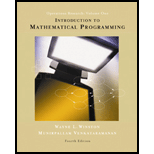
Explanation of Solution
Given:
Let
Let
Objective function:
Considering the constraints,
Constraint 1: Drug 1 must contain at least 65% of chemical 1.
Constraint 1: Drug 2 must contain at least 55% of chemical 1
Constraint 3: At most 100 oz of raw material available.
Constraint 4: At most 120 hours of skilled labor available.
Constraint 5: Chemical 1 used should be less than amount of chemical 1 produced.
Constraint 5: Chemical 2 used should be less than amount of chemical 2 produced.
Expressing the constraint 1 in terms of variables:
Expressing the constraint 2 in terms of variables:
Expressing the constraint 3 in terms of variables:
Expressing the constraint 4 in terms of variables:
Want to see the full answer?
Check out a sample textbook solution
Chapter 3 Solutions
Introduction to mathematical programming
 Operations Research : Applications and AlgorithmsComputer ScienceISBN:9780534380588Author:Wayne L. WinstonPublisher:Brooks Cole
Operations Research : Applications and AlgorithmsComputer ScienceISBN:9780534380588Author:Wayne L. WinstonPublisher:Brooks Cole
